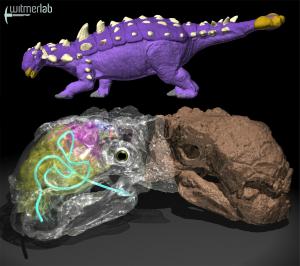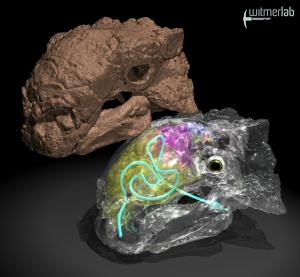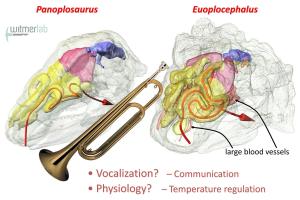
The ankylosaurid armored dinosaur Euoplocephalus (AMNH 5405). A new article confirms the highly tortuous “crazy-straw” nasal passage coiled up within the snout..
In 2008, Ryan Ridgely and I published an article on dinosaur sinuses and nasal cavities in the Anatomical Record. One of our findings was unexpected to the point of seeming almost dubious. We found that, despite what had been stated in the literature, including my own published statements, armored dinosaurs (the plant-eating, tank-like ankylosaurs) didn’t have extensive paranasal air sinuses, but instead, long tortuous nasal airways. We looked at several skulls of both the ankylosaurid Euoplocephalus and the nodosaurid Panoplosaurus (or Edmontonia…someone needs to sort that out). According to our CT-scan-based analyses, the nasal passages took a long, twisting, looping course through the snout from the nostril to the throat. No one had ever suspected such a thing, and so we wondered what the community would think of our crazy crazy-straw hypothesis. Science is all about repeatability: if a claim is true, independent workers should be able to replicate results using the same or similar data. So, it was with no small amount of excitement/fear/anxiety that we greeted the news that an independent group consisting of respected researchers from the University of Alberta (Tetsuto Miyashita, ankylosaur specialist Victoria Arbour, and Philip Currie) were testing our hypothesis based on not only our own data but also data from additional specimens. Having others check our work was the reason we had freely released our original data to the community in 2008. That said, “promoting scientific repeatability” is a much more noble concept in the abstract (gulp!). Today, the results appear in an article in the Journal of Anatomy.

Another image of the nasal airway (arrow), olfactory region of the nasal cavity (reddish), and brain endocast (blue) of Euoplocephalus.
Whew!
The Alberta team focused on Euoplocephalus, which according to Ryan’s and my work had an insanely convoluted nasal passage. Tetsuto and Victoria looked at a number of different skulls, including specimens that had their interior spaces open to examination due to breakage. They also collected CT scan data, as well as using the data on another skull that Ryan and I had posted. What they found, to our great relief, was that, yeah, we pretty much had got it right…the wild nasal passage is legit! The fact that they got the same basic conformation is reassuring in general, because there are precious few examples in the literature where totally independent groups have looked at the same CT data but using different software (they used Mimics, we used Amira) and different “eyes” (i.e., different training, biases, objectives, etc.). The project was in a pretty advanced state when they invited me on board to participate as a co-author in the next phase of the project.

This is a slide that I often use in talks to explain different ideas on nasal function. The idea behind the bugle is that the different nasal loops may have conferred species-specific or even individual-specific resonance patterns for vocal communication. The large blood vessels adjacent to the airway may have allowed the nasal apparatus to function as an intermittent counter-current heat exchanger.
Fleshing out the functional implications
In our 2008 article, Ryan and I noted some large blood vessels running right next to the crazy-straw nasal passage and suggested that the nose might be set up well physiologically for heat exchange. We also noted that the looping nasal passage was reminiscent of that of lambeosaurine hadrosaurs, which is thought maybe to have acted as a resonating chamber during vocalization (Ryan and I published an article in 2009 with David Evans that supported this notion). The 2008 article was bloated enough, and so Ryan and I didn’t chase down these functional aspects. The new Journal of Anatomy article, however, presented a new opportunity, and there was a vibrant dialog among the authors as to what all this weird nasal looping might mean. We examined both ideas (heat exchange and vocal resonance) in detail, and they’re not mutually exclusive. We also had the opportunity to explore some things that Ryan and I largely ignored, such as the unusual structure of the olfactory region of the nasal cavity and the morphology of the brain endocast and inner ear. Interestingly, the long cochlea of the inner ear suggests sensitivity to low-frequency hearing, which is consistent with the potentially low-tuned resonant properties of the nasal passages, again just as David Evans, Ryan, and I found in hadrosaurs.
Ankylosaurs get their due
I love tyrannosaurs, but they’re total media hogs. When Ryan’s and my 2008 article came out, the media jumped all over the “dinosaurs are airheads” angle and T. rex was all over the place. The ankylosaurs were largely ignored, despite being, as far as I was concerned, the most unexpected and significant outcome of that article. So, it’s great that this new project, ably led by Tetsuto Miyashita and Victoria Arbour, can allow Euoplocephalus to take center stage.
–Larry Witmer


“Science is all about repeatability: if a claim is true, independent workers should be able to replicate results using the same or similar data.”
Exactly! Great to hear you say this. A shining positive example of the benefit of free and open data sharing, for the good of science.
Now if only all paleo journals would *mandate* free and open data sharing we might actually get a lot more productive and insightful research done… 😉
http://twitter.com/#!/rmounce/status/119783262381015042 [backtrack]
This is truly awesome, Larry. I somehow missed the 2008 paper, but this one — it’s extraordinary how much information is hidden inside these skulls, and how much it tells us about the palaeobiology. The video is so startling that I made my wife watch it.
How does this research relate to the secondary palate in ankylosaurs? Does the secondary palate in ankylosaurs imply anything about possible endothermy as it does in early synapsids? Thanks.
[…] is how you fit a nasal passage roughly the length of the skull into 1/3 that distance, and while some dinosaurs have this beat by miles, oviraptorids make a better go at it than many theropods. And recall that I am projecting a […]
[…] the nasal, frontal from nasal, and probably the squamosal). This system is responsible for the crazy-straw nasal passages and expanded snout of ankylosaurians, and probably the gigantic narial aperture in ceratopsians. […]